Recent Articles
Popular Makes
Body Types
2016 Fiat 500e Road Test and Review
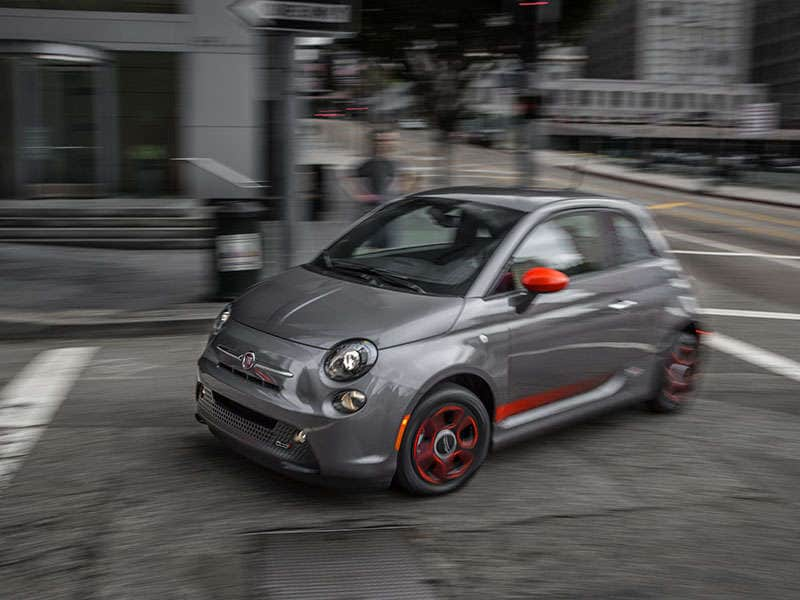
fiat 500e ・ Photo by FCA Media
The 2016 Fiat 500e is the battery powered version of Fiat’s charming little subcompact hatchback. This 3-door electric vehicle (EV) has been around since 2013 and comes into the 2016 model year sporting an upgraded infotainment system (Uconnect 5.0) with a 5-inch touchscreen, CD player, AM/FM radio, navigation, voice control and Bluetooth connectivity. Levels of noise, vibration and harshness have also been improved.
Naturally, there’s an app for it, compatible with iPhones and Android devices alike, that includes three years of connected services. It allows the user to receive information on vehicle status, charging, energy use, vehicle location and the whereabouts of charging stations. It also works out the most effective routes.
Thanks to some revised bodywork, such as a special front fascia, rear spoiler and side skirts, the 500e is more aerodynamically efficient than the regular model: 0.31 coefficient of drag compared with 0.36. That’s worth an extra five miles of highway driving.
The bad news is that the 500e is currently only available in California and Oregon. And there was an “ePass” program that used to provide owners with free rentals (12 days a year) of regular gasoline-powered vehicles for those occasional longer trips, but that has now been discontinued. That said, there’s still a lot going for the 500e, which we will go into in the following pages.
Pricing
The 2016 Fiat 500e starts at $32,795 (including destination), but there are state and federal credits for buying a vehicle that runs on alternative fuel. The federal income tax credit is $7,500. California offers up to $2,500 (depending on income) along with carpool lane access. Oregon offers a $750 rebate on wall connectors and installation. Remember also that some city spaces offer free parking and charging.
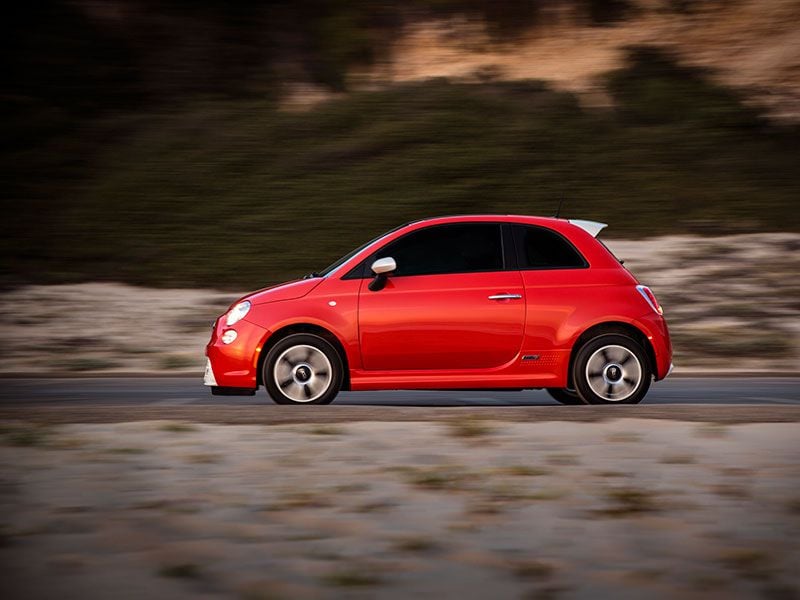
Photo by Fiat Chrysler Automobiles
Design
Where a lot of subcompacts are merely appliances for cheap personal transportation, the 500 has that something extra: personality. The current range evokes the old Fiat 500 of the late-’50s/early-’60s (known then as the Cinquecento), which was to Italy what the VW Beetle was to Germany. It’s slightly bulbous and really quite small, but that means it can accommodate a couple of adults (just) and fit into tight parking spaces that drivers of other cars wouldn’t dream of attempting.
There’s a sense of fun to the cabin as well, with bold colors and shapes. Dull charcoal plastic is kept to a minimum. Fiat also offers some fetching exterior color schemes.
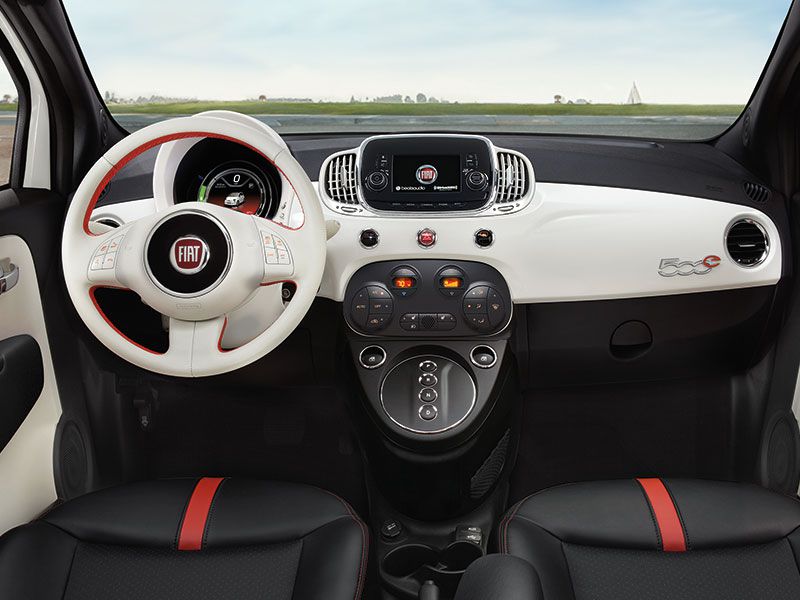
Photo by FCA Media
Comfort and Cargo
For an adult male of average build, the 500e’s front seats are just about OK. Driving it feels like wearing a pair of shoes half a size too small. Basketball players and footballers should look elsewhere. Anyone of a more petite persuasion will be fine. The 500e isn’t built for long-distance journeys anyway, so the seats work well enough for short trips. And noise levels are low, helping to keep driver fatigue at bay.
But this electric version has a drawback. The battery pack and various drivetrain components mean restricting the already tiny rear quarters to something almost unusable for anything bigger than bags or coats. With the rear seats in place, cargo space behind them is 7.0 cubic feet. These seats do split and fold in 50/50 fashion, however, for a little more flexibility. When they’re both down, cargo space expands to 26.3 cubic feet. For the sake of comparison, a Nissan Leaf enjoys 30 cubic feet.
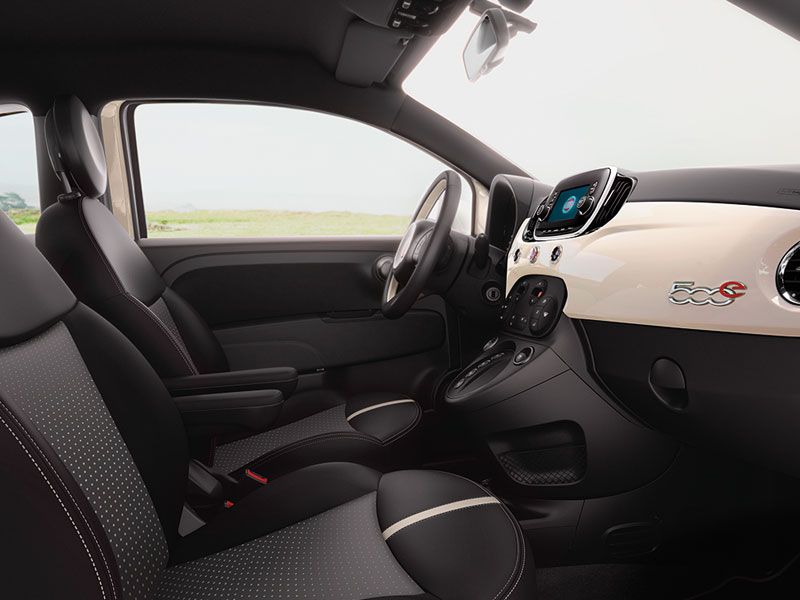
Photo by FCA Media
Features and Controls
Standard equipment is quite generous. It includes 15-inch alloy wheels, automatic climate control, cruise control, heated front seats, leather-wrapped steering wheel, rear parking sensors, heated side mirrors, power windows and locks, auto-dimming rearview mirror, leatherette upholstery, 7-inch TFT instrument cluster, Bluetooth phone/audio connectivity, USB port, auxiliary audio input, 6-speaker Alpine audio system, navigation (replacing the separate handheld Tom-Tom device from previous years), and satellite radio.
Options-wise, there’s an e-Sport package with cosmetic additions and a sunroof (which affects headroom; while you’re at the dealership, try and sit in cars with and without it to see if that could be a issue).
The steering wheel adjusts for tilt only, but does have audio controls. And finding a decent driving position is still quick and easy.
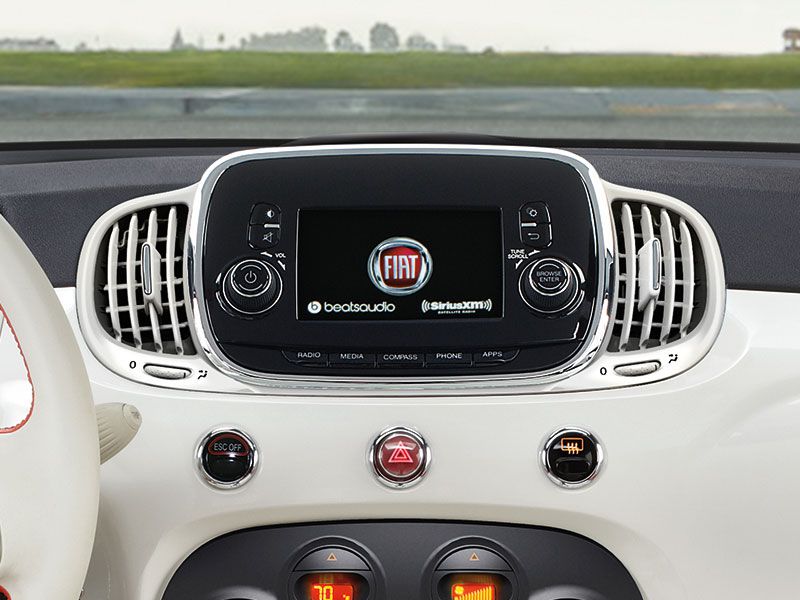
Photo by FCA Media
Safety
Standard protection includes anti-lock disc brakes front and rear, traction/stability control, plus airbags at the front, front side, side curtain and for the driver’s knees. At low speeds, this otherwise virtually silent car makes a warning sound to alert any inattentive pedestrians.
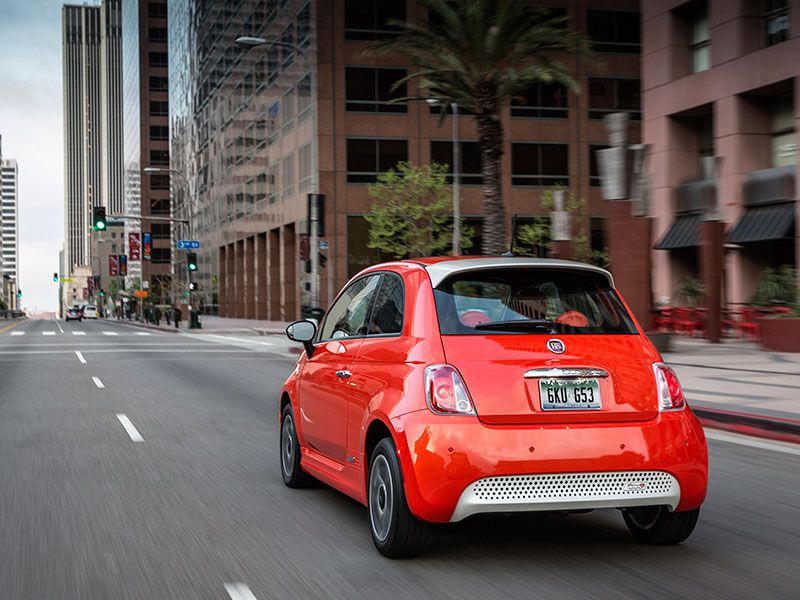
Photo by FCA Media
Engines and Economy
The front wheels are driven by an electric motor that generates 111 hp and 147 lb.-ft of torque. Its lithium-ion battery pack can be recharged in less than four hours when plugged into a 240-volt source. The company isn’t as bullish about recharge times when using a domestic 120-volt outlet, merely saying, “less than 24 hours.”
The Environmental Protection Agency (EPA) has its own way of measuring an electric vehicle’s energy consumption that it calls miles per gallon equivalent (MPGe). The 2016 Fiat 500e is rated at 122 MPGe in the city (when the regenerative braking energy feature is used more), 108 MPGe in highway driving and 116 MPGe combined. The agency reckons if a driver achieved that kind of economy with a gasoline-powered car, the yearly fuel bill would amount to just $500.
Average range is estimated at 87 miles, which could expand to more than 100 miles in purely city driving.
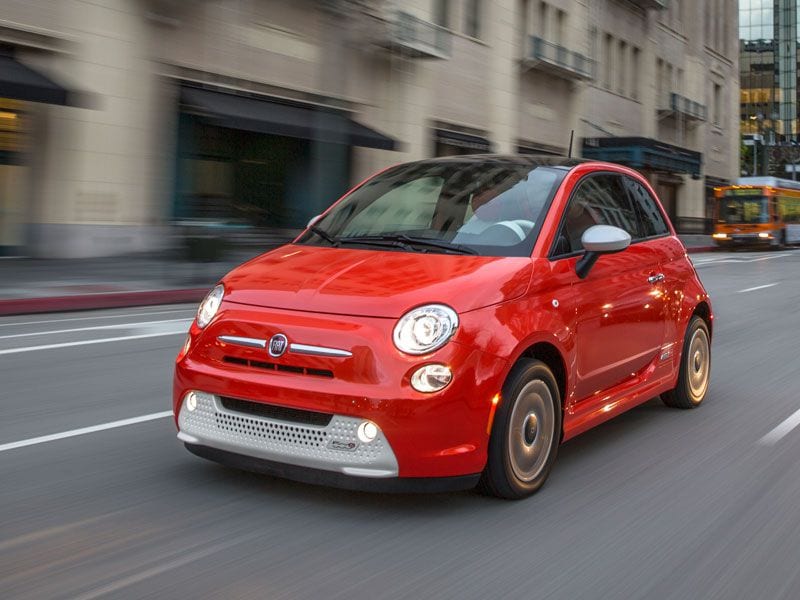
Photo by Fiat Chrysler Automobiles
Performance
In a small car like this, modest power output figures are not really a problem. There’s more than sufficient push. And electric motors are known for having their maximum torque available almost from standstill. So the diminutive 500e can zip and dart into those little gaps in city traffic we all need to dive for at times. Out on the highway, keeping up with the flow of traffic is easily achieved thanks to a top speed of 85 mph.
Unlike a lot of electric and hybrid vehicles that use regenerative braking to capture energy that would otherwise be lost, and therefore have a weird, grabbing feel to the brake pedal, the 500e’s “blended braking” system is set up to feel more like a regular car’s stoppers.
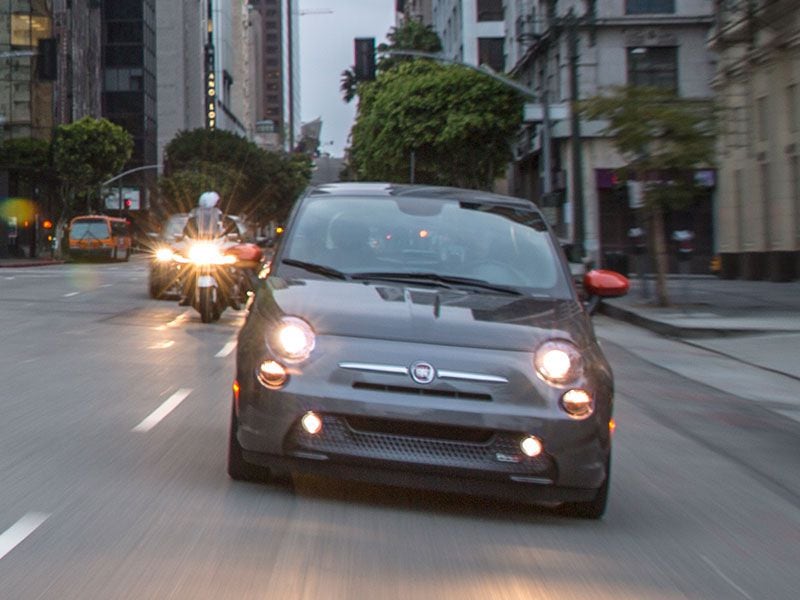
Photo by FCA Media
Final Thoughts
For someone with a fairly short commute or school run, this could be ideal. The key is routine, when a driver can accurately assess energy requirements. It’s when the unexpected happens—a sudden trip to the hospital, for example—that range anxiety creeps in. At a time when more anxiety is the last thing anyone needs.
Having the 2016 Fiat 500e as an only car is perhaps being a little too optimistic. But it could be a great second car, not just because of its low running costs, but also because it's a zero-emissions vehicle (ZEV).
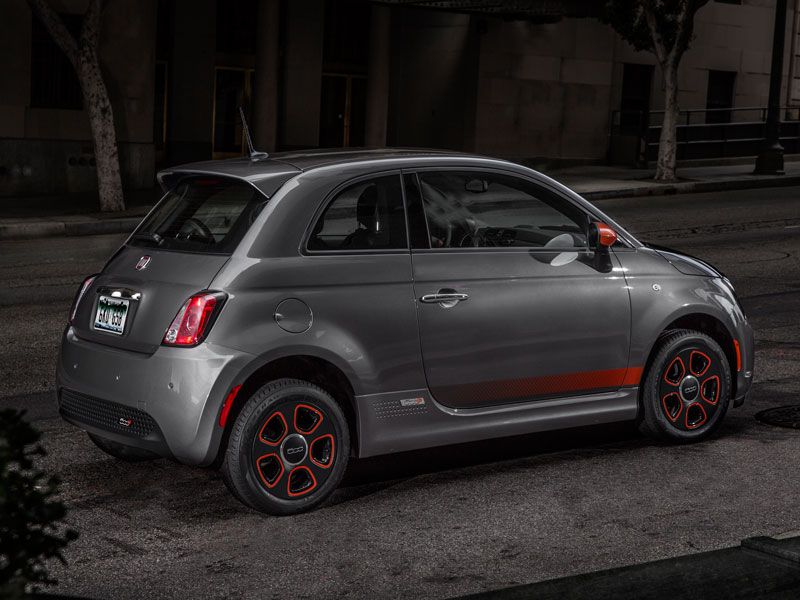
Pros and Cons
:
- Perfect for the city
- Cute styling
- Accessible price (not all of us can afford a Tesla)
- Low running costs
- Emissions-free driving
:
- Extremely limited availability
- Regular car’s restricted rear space takes an even bigger hit because of the EV hardware
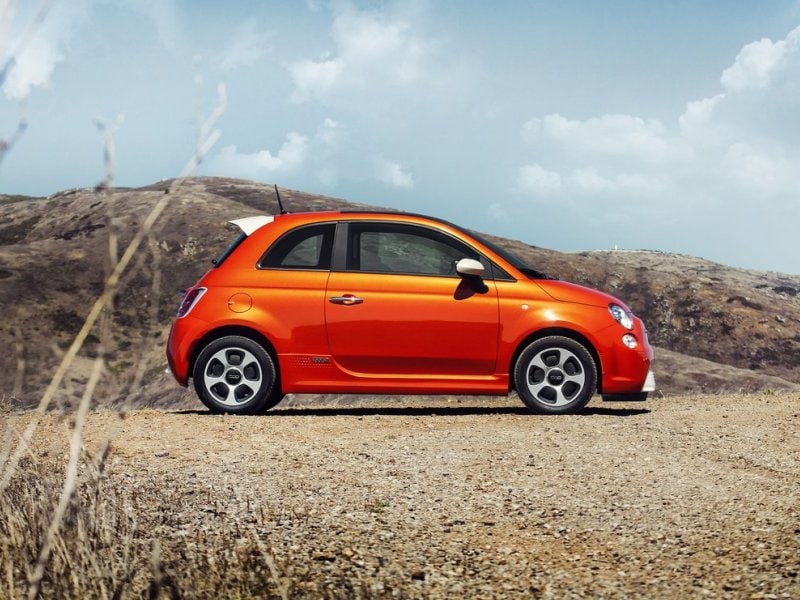
Photo by FCA Media